Date 23 April 2009 - 9 May 2009
Event ID 607343
Category Recording
Type Field Visit
Permalink http://canmore.org.uk/event/607343
NG 394 162 (centred on) An assessment survey was conducted 23 April–9 May 2009 following the discovery of medieval boat timbers on the northern edge of Loch na h-Àirde in 2000 and 2008. An aerial photography sortie facilitated by RCAHMS was conducted on 31 May 2009. Detailed surveys were conducted on the partly artificial channel 100m long which links the loch to the sea. Associated features include two nausts (stone-lined boat docks) which extend from its N side, close to the seaward end, and the tumbled foundations of at least three buildings. A promontory dun stands on a headland nearby (NG 396 159). Close to the centre of the canal is a blockage of stones, now tumbled but showing evidence of former structural cohesion. The margin of the loch follows the High Spring Tide contour, though its fill derives mainly from the surrounding catchment and is therefore partly fresh, with seawater entering only during extreme high tides. Although water now percolates through the blockage, the level in the loch remains largely constant throughout the tidal cycle.
A systematic search of the loch bed, most of which is less than 1.5m deep, was conducted with masks and snorkels. No further boat components were found, but a partly collapsed stone-built quay, now almost completely under water, extends on either side of the canal’s inshore mouth, with a gap in the middle. It was surmised that the canal was constructed so that vessels could be brought into and out of the loch, and water levels managed so that while there they would remain afloat throughout the tide, facilitating mooring or use of the quay. Since the process of bringing vessels into and out of the loch would have been quite complex, it seems likely that the system was intended for the secure over-wintering of craft, or for maintenance and perhaps boatbuilding on the loch’s shores.
One of the boat timbers found in the loch was probably from a clinker-built four-oared rowing boat c6m long. It has been radiocarbon dated to AD c1100. The other undated timber appears to be from a larger sailing vessel in the same tradition, perhaps more than 10m long. Neither craft could have had a local function in this tiny shallow loch, and were presumably there for safe-keeping or repair, or were being built. This implies that from at least the early 12th century the canal, blockage, and quay system, or some precursor of them, were in operation. Study of this remarkable maritime landscape is continuing, with research focused on determining the dates, associations and functions of the various features, including the dun.
Archive: RCAHMS (intended)
Funder: Historic Scotland
Colin Martin – Morvern Maritime Centre
Ordnance Survey licence number AC0000807262. All rights reserved.
Canmore Disclaimer.
© Copyright and database right 2024.
|
Skye, Rubh' An Dunain, 'viking Canal'
Building(S) (Period Unassigned), Harbour (Period Unassigned), Naust(S) (Period Unassigned), Quay (Period Unassigned)
Canmore ID 11028 |
|

DP 175294
Aerial photograph of the Rubh’ an Dùnain peninsula from the W, with the Cuillin Hills rising in the background. Loch na h-Airde is close to the tip of the peninsula. Loch Brittle is on the left, with Glenbrittle at its head. (Edward Martin)
Dr Colin and Dr Paula Martin
2008
© Courtesy of HES (Dr Colin and Dr Paula Martin Collection)

DP 175295
Aerial photograph of the W tip of the Rubh an Dùnain peninsula showing Loch na h-Airde and the canal linking it to the sea. The islet of Sgeir Mhòr provides a sheltered anchorage beyond the canal's mouth. (Colin Martin)
Dr Colin and Dr Paula Martin
2008
© Courtesy of HES (Dr Colin and Dr Paula Martin Collection)

DP 175296
Aerial photograph of the headland fort and canal from the SE. Underwater indications of a stone-built quay can be seen on either side of the canal’s entry to the loch. Beyond the canal entrance a basin of deeper water largely clear of weed is visible. (Colin Martin)
Dr Colin and Dr Paula Martin
2008
© Courtesy of HES (Dr Colin and Dr Paula Martin Collection)

DP 175297
Aerial photograph of the headland fort and canal from the SW. Underwater indications of a stone-built quay can be seen on either side of the canal’s entry to the loch. Beyond the canal entrance a basin of deeper water largely clear of weed is visible. (Colin Martin)
Dr Colin and Dr Paula Martin
2008
© Courtesy of HES (Dr Colin and Dr Paula Martin Collection)

DP 175298
Aerial photograph of the headland fort, canal, and loch from the S. (Colin Martin)
Dr Colin and Dr Paula Martin
2008
© Courtesy of HES (Dr Colin and Dr Paula Martin Collection)

DP 175299
Aerial photograph of Loch na h-Airde from the NE, showing the canal, headland fort (extreme centre left) and the sheltered anchorage afforded by Sgeir Mhòr (top left). (Colin Martin)
Dr Colin and Dr Paula Martin
2008
© Courtesy of HES (Dr Colin and Dr Paula Martin Collection)

DP 175300
Aerial photograph of the canal and headland fort from the NW. The cleared channel towards the mouth of the canal is evident. (Colin Martin)
Dr Colin and Dr Paula Martin
2008
© Courtesy of HES (Dr Colin and Dr Paula Martin Collection)

DP 175301
Aerial photograph of the canal and headland fort from the SW. The cleared channel towards the mouth of the canal is evident. (Colin Martin)
Dr Colin and Dr Paula Martin
2008
© Courtesy of HES (Dr Colin and Dr Paula Martin Collection)

DP 175302
Loch na h-Airde from the settlement above Rubh’ an Dùnain, looking SW.
Dr Colin and Dr Paula Martin
2008
© Courtesy of HES (Dr Colin and Dr Paula Martin Collection)

DP 175303
Loch na h-Airde from the settlement above Rubh’ an Dùnain, looking SW. The so-called ‘Tacksman’s House’ is in the foreground. (Colin Martin)
Dr Colin and Dr Paula Martin
2008
© Courtesy of HES (Dr Colin and Dr Paula Martin Collection)

DP 175304
The Slochd Dubh – Black Dyke – a stone wall running from one side of the Rubh’ an Dùnain peninsula to the other, evidently defining a territorial boundary. Though the present wall is relatively modern its line shows modifications and traces of earlier structures, and the line may be of some antiquity. (Colin Martin)
Dr Colin and Dr Paula Martin
2008
© Courtesy of HES (Dr Colin and Dr Paula Martin Collection)

DP 175305
The Slochd Dubh – Black Dyke – a stone wall running from one side of the Rubh’ an Dùnain peninsula to the other, evidently defining a territorial boundary. Though the present wall is relatively modern its line shows modifications and traces of earlier structures, and the line may be of some antiquity. (Colin Martin)
Dr Colin and Dr Paula Martin
2008
© Courtesy of HES (Dr Colin and Dr Paula Martin Collection)

DP 175306
The Slochd Dubh – Black Dyke – a stone wall running from one side of the Rubh’ an Dùnain peninsula to the other, evidently defining a territorial boundary. Though the present wall is relatively modern its line shows modifications and traces of earlier structures, and the line may be of some antiquity. (Colin Martin)
Dr Colin and Dr Paula Martin
2008
© Courtesy of HES (Dr Colin and Dr Paula Martin Collection)

DP 175307
Map showing features connected with the canal and its surroundings at Rubh’ an Dùnain. (Colin Martin)
Dr Colin and Dr Paula Martin
2008
© Courtesy of HES (Dr Colin and Dr Paula Martin Collection)

DP 175308
Plan and N elevation of the headland fort at Rubh’ an Dùnain. (Colin Martin)
Dr Colin and Dr Paula Martin
2008
© Courtesy of HES (Dr Colin and Dr Paula Martin Collection)

DP 175309
Headland fort from the W. Note the likelihood that much of its seaward interior has been lost to rock fall. (Colin Martin)
Dr Colin and Dr Paula Martin
2008
© Courtesy of HES (Dr Colin and Dr Paula Martin Collection)

DP 175310
Headland fort from the W. Note the likelihood that much of its seaward interior has been lost to rock fall. (Colin Martin)
Dr Colin and Dr Paula Martin
2008
© Courtesy of HES (Dr Colin and Dr Paula Martin Collection)

DP 175311
Vertical aerial photograph from drone of the headland fort at Rubh’ an Dùnain. (Edward Martin)
Dr Colin and Dr Paula Martin
2008
© Courtesy of HES (Dr Colin and Dr Paula Martin Collection)

DP 175312
Headland fort from the NE, looking towards Rum. (Colin Martin)
Dr Colin and Dr Paula Martin
2008
© Courtesy of HES (Dr Colin and Dr Paula Martin Collection)

DP 175313
Headland fort, N face of wall, looking S towards Rum. (Colin Martin)
Dr Colin and Dr Paula Martin
2008
© Courtesy of HES (Dr Colin and Dr Paula Martin Collection)

DP 175314
Headland fort from the NE, looking towards Rum. (Colin Martin)
Dr Colin and Dr Paula Martin
2008
© Courtesy of HES (Dr Colin and Dr Paula Martin Collection)

DP 175315
Headland fort from the NE, looking towards Rum. (Colin Martin)
Dr Colin and Dr Paula Martin
2008
© Courtesy of HES (Dr Colin and Dr Paula Martin Collection)

DP 175316
Headland fort from the NE. (Colin Martin)
Dr Colin and Dr Paula Martin
2008
© Courtesy of HES (Dr Colin and Dr Paula Martin Collection)

DP 175317
Headland fort from the NE, looking towards the islet of Sgeir Mhòr and the sheltered anchorage between. (Colin Martin)
Dr Colin and Dr Paula Martin
2008
© Courtesy of HES (Dr Colin and Dr Paula Martin Collection)

DP 175318
Headland fort, wall from interior looking N over Loch na h-Airde. (Edward Martin)
Dr Colin and Dr Paula Martin
2008
© Courtesy of HES (Dr Colin and Dr Paula Martin Collection)

DP 175319
Headland fort, aerial view from drone looking S. (Edward Martin)
Dr Colin and Dr Paula Martin
2008
© Courtesy of HES (Dr Colin and Dr Paula Martin Collection)

DP 175320
Headland fort, entrance. Scale 2 metres. (Colin Martin)
Dr Colin and Dr Paula Martin
2008
© Courtesy of HES (Dr Colin and Dr Paula Martin Collection)

DP 175321
Headland fort, intramural chamber adjacent to entrance. Scale 2 metres. (Colin Martin)
Dr Colin and Dr Paula Martin
2008
© Courtesy of HES (Dr Colin and Dr Paula Martin Collection)

DP 175322
Headland fort, interior of wall showing scarcement. Scale 2 metres. (Colin Martin)
Dr Colin and Dr Paula Martin
2008
© Courtesy of HES (Dr Colin and Dr Paula Martin Collection)

DP 175323
Headland fort, detail of chamber and external wall (on right) showing evidence of re-build. Scale 2 metres. (Colin Martin)
Dr Colin and Dr Paula Martin
2008
© Courtesy of HES (Dr Colin and Dr Paula Martin Collection)

DP 175324
Headland fort (skylined, on left), the two nausts below it, and the canal leading into Loch na h-Airde. The islet of Sgeir Mhòr and the sheltered anchorage lie beyond. (Colin Martin)
Dr Colin and Dr Paula Martin
2008
© Courtesy of HES (Dr Colin and Dr Paula Martin Collection)

DP 175325
Headland fort (skylined, on left), the two nausts below it, and the canal leading into Loch na h-Airde. The islet of Sgeir Mhòr and the sheltered anchorage lie beyond. Rum is on the horizon, and the headland on the far left is Dùnan Thalasgair on Eigg, which according to tradition was a watch-post and signal-stance linked to Rubh’ an Dùnain. (Colin Martin)
Dr Colin and Dr Paula Martin
2008
© Courtesy of HES (Dr Colin and Dr Paula Martin Collection)

DP 175326
Vertical photograph by aerial drone of the two nausts with their upper hauling bays. (Edward Martin)
Dr Colin and Dr Paula Martin
2008
© Courtesy of HES (Dr Colin and Dr Paula Martin Collection)

DP 175327
The nausts at mid-tide, with the water just beginning to enter the lower basins. (Colin Martin)
Dr Colin and Dr Paula Martin
2008
© Courtesy of HES (Dr Colin and Dr Paula Martin Collection)

DP 175328
Rectified vertical photomosaic of the canal, quay, and nausts taken by aerial drone. (Edward Martin)
Dr Colin and Dr Paula Martin
2008
© Courtesy of HES (Dr Colin and Dr Paula Martin Collection)

DP 175329
Interpretative survey drawing derived from the rectified vertical photomosaic of the canal, quay, and nausts. (Colin Martin)
Dr Colin and Dr Paula Martin
2008
© Courtesy of HES (Dr Colin and Dr Paula Martin Collection)

DP 175330
Oblique panorama of the upper canal and nausts. (Edward Martin)
Dr Colin and Dr Paula Martin
2008
© Courtesy of HES (Dr Colin and Dr Paula Martin Collection)

DP 175331
The upper canal from the edge of the northernmost naust. The 2-m pole marks a distinctive change in the stonework of the revetment on the far side of the canal. (Colin Martin)
Dr Colin and Dr Paula Martin
2008
© Courtesy of HES (Dr Colin and Dr Paula Martin Collection)

DP 175332
Detail of the change in the stonework between the lower and upper sectors of the canal. Scale 2 metres. (Colin Martin)
Dr Colin and Dr Paula Martin
2008
© Courtesy of HES (Dr Colin and Dr Paula Martin Collection)

DP 175333
The lower end of the canal’s outlet to the sea, photographed at low water. This sector is not strictly a canal, but a cleared strip which runs towards the nausts to facilitate landing. Even so, some revetment to the edges is evident. The headland fort is visible at the upper left. (Colin Martin)
Dr Colin and Dr Paula Martin
2008
© Courtesy of HES (Dr Colin and Dr Paula Martin Collection)

DP 175334
The upper canal leading into Loch na h-Airde. The naust entrances are partly obscured (centre right), while the blockage of the canal towards its entrance into the loch is clear. (Colin Martin)
Dr Colin and Dr Paula Martin
2008
© Courtesy of HES (Dr Colin and Dr Paula Martin Collection)

DP 175335
The upper canal leading into Loch na h-Airde, with the blockage part-way along it. The left-hand revetment is relatively intact, but that on the right appears to have been dismantled to its foundations and the stones thrown onto the bank. Tradition asserts that this was done to bring larger vessels into the loch. (Colin Martin)
Dr Colin and Dr Paula Martin
2008
© Courtesy of HES (Dr Colin and Dr Paula Martin Collection)

DP 175336
The upper canal leading into Loch na h-Airde, with the blockage part-way along it. The left-hand revetment is relatively intact, but that on the right appears to have been dismantled to its foundations and the stones thrown onto the bank. Tradition asserts that this was done to bring larger vessels into the loch. Scale 2 metres. (Colin Martin)
Dr Colin and Dr Paula Martin
2008
© Courtesy of HES (Dr Colin and Dr Paula Martin Collection)

DP 175337
The upper canal leading into Loch na h-Airde, with the blockage part-way along it. (Colin Martin)
Dr Colin and Dr Paula Martin
2008
© Courtesy of HES (Dr Colin and Dr Paula Martin Collection)

DP 175338
Oblique photomosaic taken from an elevated pole of the canal blockage. Scales 2 metres. (Edward Martin)
Dr Colin and Dr Paula Martin
2008
© Courtesy of HES (Dr Colin and Dr Paula Martin Collection)

DP 175339
Rectified vertical mosaic taken by aerial drone of the stone-built quay features on either side of the canal entrance into Loch na h-Airde. (Edward Martin)
Dr Colin and Dr Paula Martin
2008
© Courtesy of HES (Dr Colin and Dr Paula Martin Collection)

DP 175340
Tumbled stonework from the quay on the E side of the canal entrance into Loch na h-Airde. (Colin Martin)
Dr Colin and Dr Paula Martin
2008
© Courtesy of HES (Dr Colin and Dr Paula Martin Collection)

DP 175341
The edge of the quay on the E side of the canal entrance into Loch na h-Airde. (Colin Martin)
Dr Colin and Dr Paula Martin
2008
© Courtesy of HES (Dr Colin and Dr Paula Martin Collection)

DP 175342
The edge of the quay on the E side of the canal entrance into Loch na h-Airde. (Colin Martin)
Dr Colin and Dr Paula Martin
2008
© Courtesy of HES (Dr Colin and Dr Paula Martin Collection)

DP 175343
The basin beyond the entrance of the canal into Loch na h-Airde is deeper than its surroundings, relatively weed free, and filled with soft mud. Organic material tends to accumulate here. The items visible in this photograph are probably modern in origin but given its location adjcent to the quay earlier material may well be buried in the aenerobic substratum. (Colin Martin)
Dr Colin and Dr Paula Martin
2008
© Courtesy of HES (Dr Colin and Dr Paula Martin Collection)

DP 175344
Boat component discovered at the N end of the loch by Dr David MacFadyen in 2000. It is a bite, part of a small four-oared boat of Norse type, and has been C14-dated to around 1100 AD. Scale 50 centimetres. (Colin Martin)
Dr Colin and Dr Paula Martin
2008
© Courtesy of HES (Dr Colin and Dr Paula Martin Collection)

DP 175345
Boat component discovered at the N end of the loch by Dr David Macfadyen in 2000. It is a bite, part of a small four-oared boat of Norse type, and has been C14-dated to around 1100 AD. Scale 50 centimetres. (Colin Martin)
Dr Colin and Dr Paula Martin
2008
© Courtesy of HES (Dr Colin and Dr Paula Martin Collection)

DP 175346
Treenail, or wooden fastening peg, from a boat component discovered at the N end of the loch by Dr David MacFadyen in 2000 which has been C14-dated to around 1100 AD. The treenail has been tightened with a wedge. Scale in centimetres. (Colin Martin)
Dr Colin and Dr Paula Martin
2008
© Courtesy of HES (Dr Colin and Dr Paula Martin Collection)

DP 175347
Part of a boat component discovered at the N end of the loch by Dr David Macfadyen in 2000. The piece is a bite, part of a small four-oared boat of Norse type, and has been C14-dated to around 1100 AD. This detail shows a wooden peg or treenail, and a slot cut in its side. Scale in centimetres. (Colin Martin)
Dr Colin and Dr Paula Martin
2008
© Courtesy of HES (Dr Colin and Dr Paula Martin Collection)

DP 175348
Top and side views of the bite found at the N end of the loch by Dr David Macfadyen in 2000. Below is a reconstruction of how it might have fitted into the midships section of a four-oared boat of the Norse faering type. (Colin Martin)
Dr Colin and Dr Paula Martin
2008
© Courtesy of HES (Dr Colin and Dr Paula Martin Collection)

DP 175349
Access to Rubh’ an Dùnain is not easy. By land the loch is a 5-mile trek each way, often in poor weather and carrying equipment. This severely restricted work on the site in 2009. (Colin Martin)
Dr Colin and Dr Paula Martin
2008
© Courtesy of HES (Dr Colin and Dr Paula Martin Collection)

DP 175350
Access by boat from Glenbrittle is convenient but entirely weather dependant. This demanded a much more flexible approach predicated on exploiting windows of opportunity with a small family-based team. Here Dr Paula Martin and Peter Martin prepare to set out for the site with a load of equipment. (Colin Martin)
Dr Colin and Dr Paula Martin
2008
© Courtesy of HES (Dr Colin and Dr Paula Martin Collection)

DP 175351
Fast, comfortable access is available – at a price – by rigid inflatable boat from Elgol. This occasion, in 2012, was underwritten by the BBC, who were making a programme. At centre is Dr Jon Henderson (University of Nottingham) who was presenting the programme and providing expertise on the archaeology of the site. On the right is Edward Martin, who has been developing drone photography and photographic rectification for the project. (Colin Martin)
Dr Colin and Dr Paula Martin
2008
© Courtesy of HES (Dr Colin and Dr Paula Martin Collection)

DP 175352
Filming, archaeological, and aerial drone equipment come ashore at Rubh’ an Dùnain. The drone system is in the box, centre foreground. (Colin Martin)
Dr Colin and Dr Paula Martin
2008
© Courtesy of HES (Dr Colin and Dr Paula Martin Collection)

DP 175353
Setting up base camp on site in 2009. (Colin Martin)
Dr Colin and Dr Paula Martin
2008
© Courtesy of HES (Dr Colin and Dr Paula Martin Collection)

DP 175354
Setting out one of the primary baselines. (Colin Martin)
Dr Colin and Dr Paula Martin
2008
© Courtesy of HES (Dr Colin and Dr Paula Martin Collection)

DP 175355
Dr Chris Burgess established a survey network with Total Station. (Edward Martin)
Dr Colin and Dr Paula Martin
2008
© Courtesy of HES (Dr Colin and Dr Paula Martin Collection)

DP 175356
Within the Total Station network much of the detailed survey was done by plane table. (Colin Martin)
Dr Colin and Dr Paula Martin
2008
© Courtesy of HES (Dr Colin and Dr Paula Martin Collection)

DP 175357
Dr Chris Burgess established a survey network with Total Station. Within this framework the detailed survey was carried out with traditional methods. (Colin Martin)
Dr Colin and Dr Paula Martin
2008
© Courtesy of HES (Dr Colin and Dr Paula Martin Collection)

DP 175358
Beginning a survey of the canal. From left, Roger Miket, who first recognised the site’s potential in the 1980s, Dr David Caldwell of the National Museums of Scotland, and Peter Martin (Colin Martin)
Dr Colin and Dr Paula Martin
2008
© Courtesy of HES (Dr Colin and Dr Paula Martin Collection)

DP 175359
Roger Miket plots measurements as Peter Martin calls them out.
Dr Colin and Dr Paula Martin
2008
© Courtesy of HES (Dr Colin and Dr Paula Martin Collection)

DP 175360
The site was potentially dangerous, and risk assessments were rigorous. Project Director Dr Colin Martin is more secure than he looks as he records details of the headland fort. (Paula Martin)
Dr Colin and Dr Paula Martin
2008
© Courtesy of HES (Dr Colin and Dr Paula Martin Collection)

DP 175361
Edward Martin setting up the elevated pole-mounted camera system in 2009. (Colin Martin)
Dr Colin and Dr Paula Martin
2008
© Courtesy of HES (Dr Colin and Dr Paula Martin Collection)

DP 175362
Edward Martin prepares to take oblique photographs of the headland fort with the elevated pole-mounted camera system in 2009. (Colin Martin)
Dr Colin and Dr Paula Martin
2008
© Courtesy of HES (Dr Colin and Dr Paula Martin Collection)

DP 175363
Edward Martin composing the picture and adjusting the camera on the elevated pole-mounted camera system from his computer on the ground. (Colin Martin)
Dr Colin and Dr Paula Martin
2008
© Courtesy of HES (Dr Colin and Dr Paula Martin Collection)

DP 175364
Edward Martin, filmed by a BBC crew, steadies his aerial drone by the mouth of the canal prior to a photographic sortie. (Colin Martin)
Dr Colin and Dr Paula Martin
2008
© Courtesy of HES (Dr Colin and Dr Paula Martin Collection)

DP 175365
Attempts have been made to search the shallow loch bed, since it is likely that further early boat components will be found there. The simplest method has been to use a small inflatable raft pulled along rope lanes stretched across the loch by a snorkeller. (Colin Martin)
Dr Colin and Dr Paula Martin
2008
© Courtesy of HES (Dr Colin and Dr Paula Martin Collection)

DP 175366
Attempts have been made to search the shallow loch bed, since it is likely that further early boat components will be found there. The simplest method has been to use a small inflatable raft pulled along rope lanes stretched across the loch by a snorkeller. (Colin Martin)
Dr Colin and Dr Paula Martin
2008
© Courtesy of HES (Dr Colin and Dr Paula Martin Collection)

DP 175367
Attempts have been made to search the shallow loch bed, since it is likely that further early boat components will be found there. The simplest method has been to use a small inflatable raft pulled along rope lanes stretched across the loch by a snorkeller. (Colin Martin)
Dr Colin and Dr Paula Martin
2008
© Courtesy of HES (Dr Colin and Dr Paula Martin Collection)

DP 175368
Trials have been made using sector scanning to search the loch bed for archaeological features. Here Dr Brian Abbott prepares the equipment for a test run. (Colin Martin)
Dr Colin and Dr Paula Martin
2008
© Courtesy of HES (Dr Colin and Dr Paula Martin Collection)

DP 175369
Trials have been made using sector scanning to search the loch bed for archaeological features. The equipment is seen here assembled and ready for launching. (Colin Martin)
Dr Colin and Dr Paula Martin
2008
© Courtesy of HES (Dr Colin and Dr Paula Martin Collection)

DP 175370
Trials have been made using sector scanning to search the loch bed for archaeological features. The equipment is seen here being positioned. Results so far have been encouraging, but a more sustained programme is required. (Colin Martin)
Dr Colin and Dr Paula Martin
2008
© Courtesy of HES (Dr Colin and Dr Paula Martin Collection)

DP 175371
Trials have been made using sector scanning to search the loch bed for archaeological features. Here the equipment has been positioned near the canal mouth. Results so far have been encouraging, but a more sustained programme is required. (Colin Martin)
Dr Colin and Dr Paula Martin
2008
© Courtesy of HES (Dr Colin and Dr Paula Martin Collection)

DP 175372
More work on studying the historic environment of Rubh’ an Dùnain is required. Here Dr Richard Tipping of the University of Stirling obtains some test cores from the loch bed. (Edward Martin)
Dr Colin and Dr Paula Martin
2008
© Courtesy of HES (Dr Colin and Dr Paula Martin Collection)

DP 175373
Dr Colin Martin (left), the Project Director, confers on site with Dr David Macfadyen (right), who found the 12th century boat timber in 2000.With them is Gavin Parsons of Sabhal Mor Ostaig, the Gaelic College on Skye, who is advising on place-name studies and other local cultural issues. (Edward Martin)
Dr Colin and Dr Paula Martin
2008
© Courtesy of HES (Dr Colin and Dr Paula Martin Collection)

DP 175374
Dr Colin Martin (left), the Project Director, confers on site with Dr David Macfadyen (right), who found the 12th century boat timber in 2000.With them is Gavin Parsons of Sabhal Mor Ostaig, the Gaelic College on Skye, who is advising on place-name studies and other local cultural issues. (Edward Martin)
Dr Colin and Dr Paula Martin
2008
© Courtesy of HES (Dr Colin and Dr Paula Martin Collection)

DP 175375
This site has elicited much interest and discussion from heritage agencies and others. Here, seated on the remains of a Neolithic chambered cairn overlooking Loch na h-Airde in September 2013, an informal international seminar is taking place. From left, Philip Robertson (Historic Scotland), George Geddes (Royal Commission on the Ancient and Historic Monuments of Scotland), Edward Martin (archaeological photographer), and Dr Ian MacLeod (Western Australian Museum). Behind the camera is Dr Colin Martin (University of St Andrews). (Colin Martin)
Dr Colin and Dr Paula Martin
2008
© Courtesy of HES (Dr Colin and Dr Paula Martin Collection)

DP 175376
Philip Robertson of Historic Scotland takes a break from assessing Rubh’ an Dùnain’s archaeological and historical significance to Scotland and the wider world. (Paula Martin)
Dr Colin and Dr Paula Martin
2008
© Courtesy of HES (Dr Colin and Dr Paula Martin Collection)
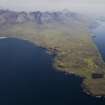
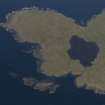
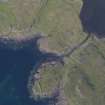
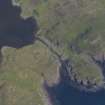
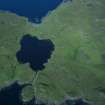
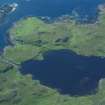
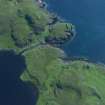
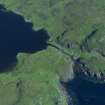
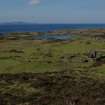
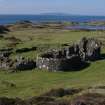

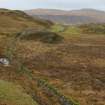
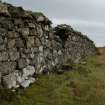
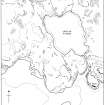
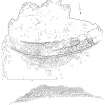
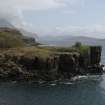
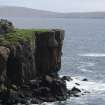
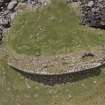
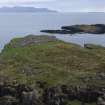
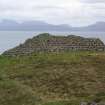

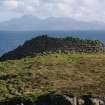
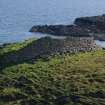
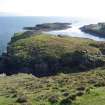
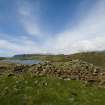
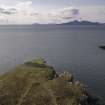
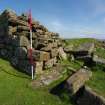
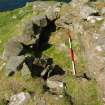
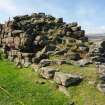
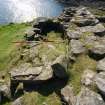
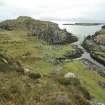
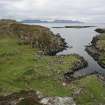
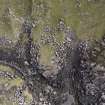
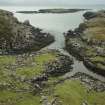

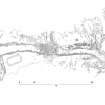
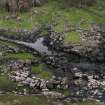
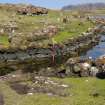

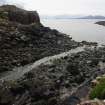
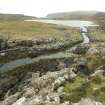

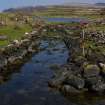
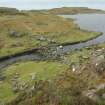
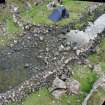
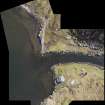
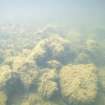
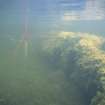
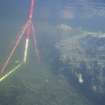
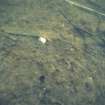
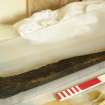
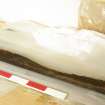

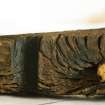
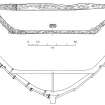
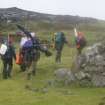
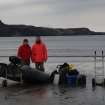
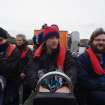
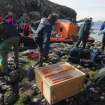
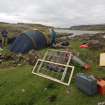
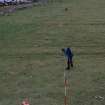
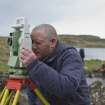
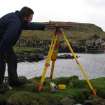
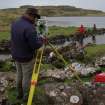
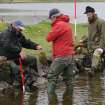



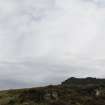
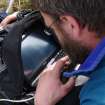
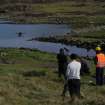
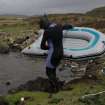
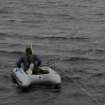

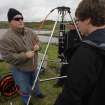
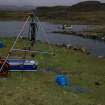
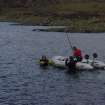
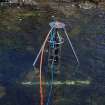
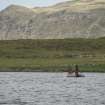





Aerial photograph of the canal and headland fort from the NW. The cleared channel towards the mouth of the canal is evident. (Colin Martin)
Aerial photograph of the canal and headland fort from the SW. The cleared channel towards the mouth of the canal is evident. (Colin Martin)
Loch na h-Airde from the settlement above Rubh’ an Dùnain, looking SW.




